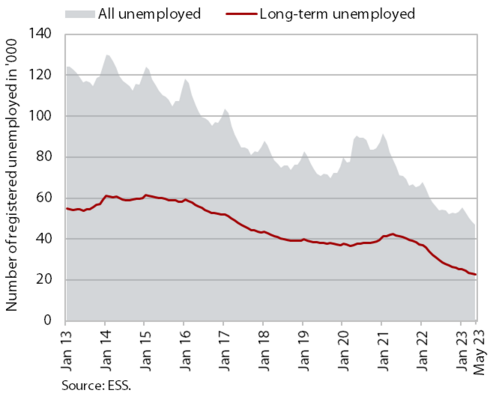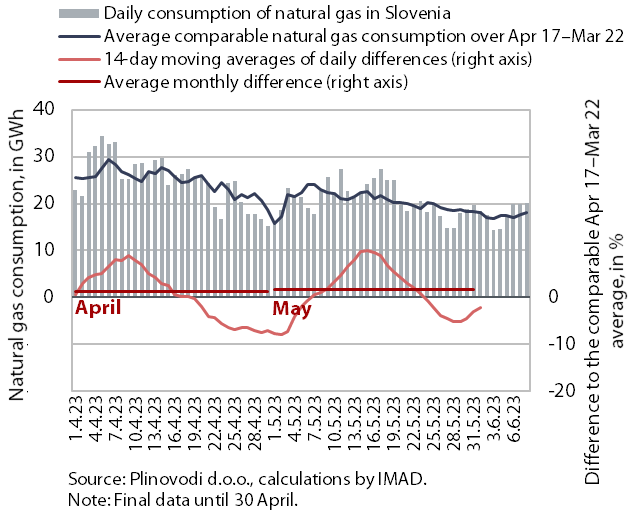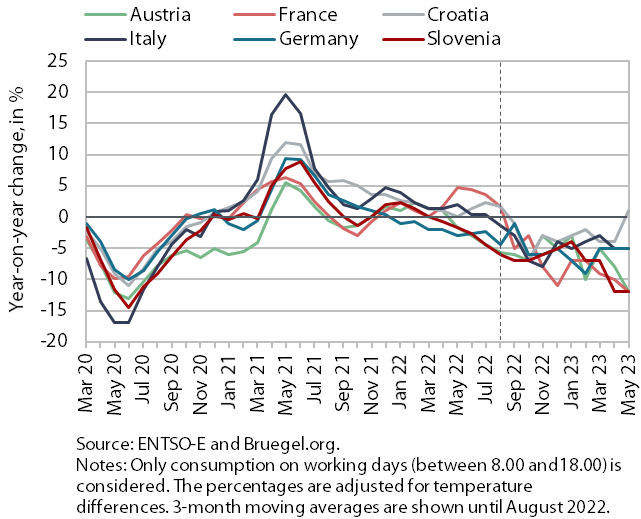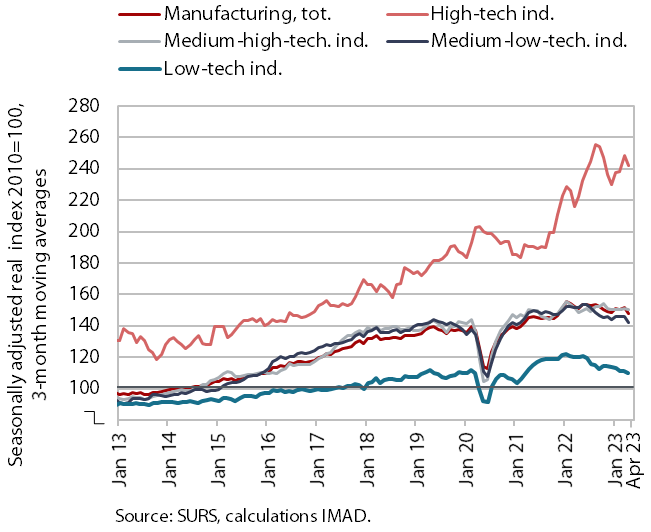Charts of the Week
Charts of the week from 5 to 9 June 2023: number of registered unemployed, natural gas consumption, electricity consumption and manufacturing
The number of registered unemployed fell further in May, by 15.5% year-on-year. The number of long-term unemployed also declined, by slightly more than one-quarter. Similar to April, gas consumption in May was slightly above the comparable average consumption of previous years. This is likely due to again lower temperatures, which extended the heating season, as well as a more favourable development of gas market prices, which have prompted some companies to increase their production again. Electricity consumption in May was 12% lower year-on-year – the same decrease as in April. After rising slightly in the first quarter, manufacturing output fell sharply in April. It fell by 7.2% year-on-year (working day adjusted), with the largest declines in the energy-intensive paper and chemical industries.
Number of registered unemployed, May 2023

According to the seasonally adjusted data, the monthly decline in the number of registered unemployed was similar in May (-1.3%) as in the previous months. According to original data, 47,186 people were unemployed at the end of May, 2.9% less than at the end of April. Unemployment was down 15.5% year-on-year. Amid a severe labour shortage, the number of long-term unemployed and unemployed over 50 also decreased (by 27.2% and 15.7% respectively).
Natural gas consumption, May 2023

Similar to April, gas consumption in May was slightly above the comparable average consumption of previous years. In previous months, lower gas consumption was linked to lower production in part of the industry due to high gas prices and to government measures to encourage more rational use. The relatively high consumption in recent months was also influenced by the colder temperatures, which extended the heating season. The market prices of gas, which fell below EUR 30 at the end of May and were thus lower than in the whole of last year, have prompted some companies to increase their production again, including in the steel industry, where production has been running at full capacity again since April. Slovenia has almost reached the EU target of reducing gas consumption by at least 15% between August last year and March this year (a 14% reduction). In the first two months of the one-year extension of the EU regulation on reducing gas demand, gas consumption in Slovenia was even slightly higher than the comparable average consumption (by just over 1%). Under the regulation, Slovenia can exclude from the calculation the gas consumed in the new gas-steam unit of the Ljubljana heating plant, which has not yet been put into operation.
Electricity consumption, May 2023

Electricity consumption in May was 12% lower year-on-year – the same decrease as in April. In our estimation, this was mainly due to lower consumption in the energy-intensive part of industry as a result of high electricity prices. The shutdown of primary aluminium production in Talum since April has also contributed to the lower consumption compared to the same period last year. Household consumption may also have contributed to lower year-on-year consumption as a result of more rational use of energy. Slovenia’s main trading partners also recorded a year-on-year decline in consumption in May (Austria and France by 12%, Italy and Germany by 5%), with the exception of Croatia, where consumption was 1% higher year-on-year.
Manufacturing, April 2023

After rising slightly in the first quarter, manufacturing output fell sharply in April. It was lower than in the first quarter in all industry groups. It was 7.2% lower than in April last year (working day adjusted). The sharpest decline was again seen in the paper and chemical industries, where the year-on-year decline deepened, as it did in other energy-intensive industries. Most other industries also recorded larger year-on-year declines than in the first quarter. After rising in the first quarter, the manufacture of electrical equipment and, in our estimation, pharmaceutical industry also fell year-on-year. Manufacture of motor vehicles remained higher than a year ago. The prospects for manufacturing have continued to deteriorate in recent months. Most companies do not expect exports to pick up by the end of the summer and expectations for a pick-up in production remain subdued.
